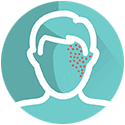Key points
- Shingles is a painful, usually itchy, rash that develops on one side of the face or body.
- The rash consists of blisters that typically scab over in 7 to 10 days, clearing up within 2 to 4 weeks.
- Long-term nerve pain is the most common complication of shingles.

Early symptoms
People can have pain, itching, or tingling in the area where the rash will develop. This early warning sign can happen several days before the rash appears. People can also have a fever before the rash appears.
Common symptoms
The shingles rash most commonly appears in a single stripe around the left or right side of the body. The rash can also occur on one side of the face.

The rash can be more widespread on the body and look similar to a chickenpox rash. This is very rare and usually occurs in people with weakened immune systems.
In addition to the common rash, symptoms of shingles can also include:
- Fever
- Headaches
- Chills
- Upset stomach
Testimonial
"Five years later, I still take prescription medication for pain. My shingles rash quickly developed into open, oozing sores that, in only a few days, required me to be hospitalized. I could not eat, sleep, or perform even the most minor tasks. It was totally debilitating. The pain still limits my activity levels to this day."
-A 63-year-old harpist unable to continue playing because of shingles.
Complications
Shingles can lead to serious complications.
Long-term nerve pain
The most common complication of shingles is long-term nerve pain called postherpetic neuralgia, or PHN.
PHN occurs where the shingles rash was located, even after the rash clears up. It can last for months or years after the rash goes away. PHN is extremely painful and can interfere with daily life.
Who is at risk
About 10% to 18 % of people who have shingles also experience PHN. Your risk of PHN increases with age. Compared to a younger person with shingles, an older adult with shingles is more likely to develop PHN; and have longer lasting and more severe pain. People younger than 40 years old rarely experience PHN.
Other serious complications
- Shingles on the face can affect the eye and cause vision loss.
- The shingles rash can also become infected with bacteria.
- Very rarely, shingles can also lead to:
- Infection of the lungs (pneumonia)
- Hearing problems
- Brain inflammation (encephalitis)
- Death
- Infection of the lungs (pneumonia)
Who is at risk
People with weakened immune systems are more likely to experience complications from shingles. They are more likely to have a severe, long-lasting rash.
